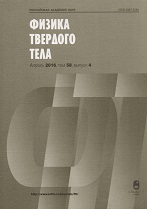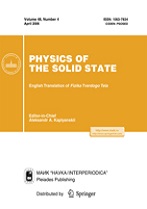|
Эта публикация цитируется в 6 научных статьях (всего в 6 статьях)
Металлы
Half-metallic characteristic in the new full-heusler SrYO$_{2}$ (Y = Sc, Ti, V, and Cr)
N. Nazemi, F. Ahmadian
Department of Physics, Shahreza Branch, Islamic Azad University,
Shahreza, Iran
Аннотация:
Half-metallic properties of SrYO$_{2}$ (Y = Sc, Ti, V, and Cr) full-Hensler compounds were studied using full-potential linearized augmented plane wave method based on density functional theory. The negative formation energies of SrYO$_{2}$ (Y = Sc, Ti, V, and Cr) alloys confirmed that they can be synthesized experimentally. Total energy calculations showed that AlCu$_{2}$Mn-type structure was the ground state structure in all compounds. In both structures, SrYO$_{2}$ (Y=Ti, V, and Cr) alloys were half-metallic ferrromagnets, while SrScO$_{2}$ was a non- magnetic metal. The origin of half-metallicity was verified for SrCrO$_{2}$. SrYO$_{2}$ (Y = Ti, V, and Cr) alloys in both structures were half-metals in a wide range of lattice constants indicating that they are quite robust against hydrostatic strains. The magnetization of SrYO$_{2}$ (Y = Ti, V, and Cr) alloys was mainly originated from the 3$d$ electrons of Y( = Ti, V, and Cr) atoms and followed the Slater-Pauling rule: $M_{\operatorname{tot}}$=Z$_{\operatorname{tot}}$-12. Generally, It is expected that SrYO$_{2}$ (Y = Ti, V, and Cr) alloys are promising and interesting candidates in the future spintronic field.
Поступила в редакцию: 10.07.2018
Образец цитирования:
N. Nazemi, F. Ahmadian, “Half-metallic characteristic in the new full-heusler SrYO$_{2}$ (Y = Sc, Ti, V, and Cr)”, Физика твердого тела, 61:1 (2019), 41; Phys. Solid State, 61:1 (2019), 1–10
Образцы ссылок на эту страницу:
https://www.mathnet.ru/rus/ftt8940 https://www.mathnet.ru/rus/ftt/v61/i1/p41
|


| Статистика просмотров: |
| Страница аннотации: | 59 | | PDF полного текста: | 19 |
|





 Обратная связь:
Обратная связь: Пользовательское соглашение
Пользовательское соглашение
 Регистрация посетителей портала
Регистрация посетителей портала Логотипы
Логотипы









 Цитирование в формате
Цитирование в формате 
